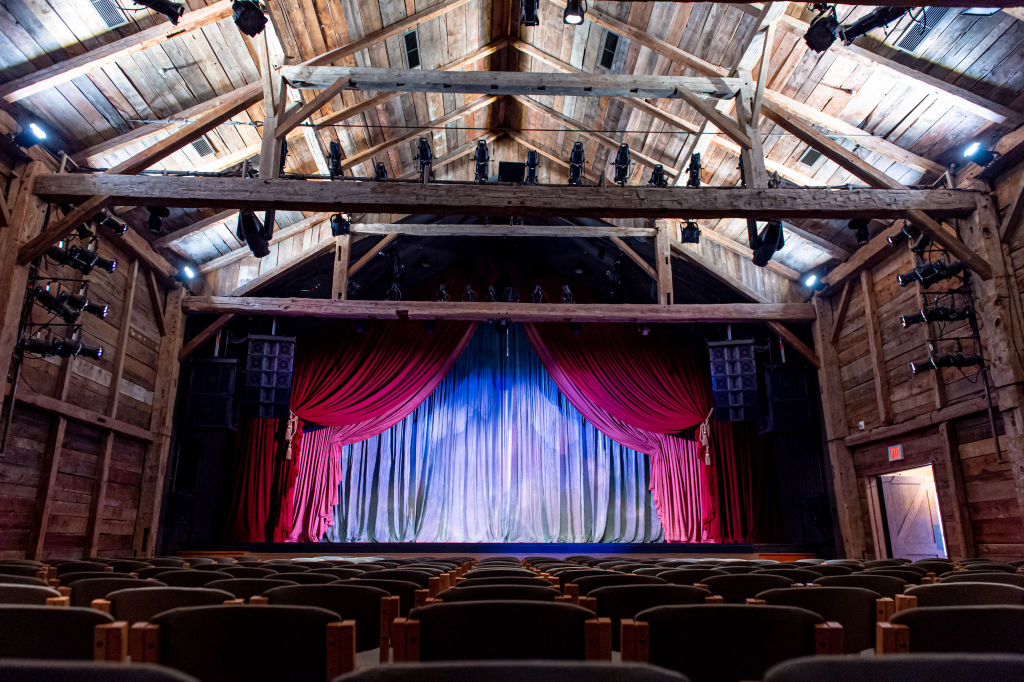Music
 The Barns at Wolf Trap. Photo by Rich Kessler Photography.
The Barns at Wolf Trap. Photo by Rich Kessler Photography.
This Is 40: The Barns at Wolf Trap Celebrates a Legacy of Intimacy
October 1, 2021 @ 10:00am
In January 1982, the Wolf Trap Foundation for the Performing Arts kicked off its first musical season at The Barns, as its more than 200-year-old wooden structures filled the role of full-time music venue. The Washington Post review by Joanne Sheehy Hoover described the building as a “merite un detour,” or something worth experiencing. She described the intimacy of the less-than-400-seat venue: how the close quarters elicited a sensation of exclusivity, the welcoming atmosphere stood out as both unique yet familiar, and the sound seemed rich and whole bouncing between the warm, weathered walls.
Just two years prior, the same fixtures sat in upstate New York, playing home to not much at all. Wolf Trap founder and DMV icon Catherine Filene Shouse purchased the Scottish-German barns before moving them from upstate New York to Virginia, where they have operated as an intimate space for a wide variety of genres — from indie darlings to operatic staples — for the past 40 years.
“I don’t think it’s surprising,” says Arvind Manocha, president and CEO of Wolf Trap, about The Barns longevity. “It’s surviving and thriving, and it’s a very consistent venue. The reason it’s so successful is the experience of seeing an artist in a room that small with that kind of authenticity. It’s hard to replicate that in other spaces. It’s not built to feel like an old structure. It’s an old barn given new life. I’d like to think there is something in those 300-year-old beams of wood that contributes to that feeling.”
An Enduring Intimacy
The Barns allows for balance at Wolf Trap. While the foundation’s Filene Center dominates the summer with captivating performances intended to create spectacles for throngs of attendees, The Barns is activated as an opposite — a subtle yin to a raucous yang.
“It allows us to do things we couldn’t and wouldn’t do at the Filene Center,” Manocha says. “At The Barns, it can be a singer-songwriter onstage: one musician, one instrument. In that sense, it rounds out the experience. If you’re a music fan who loves going to Wolf Trap, you can do it in a big way and do it in a very intimate way.”
This balance is important for the D.C. area, too, as venues like The Barns help further establish the region as a hotbed for musicians on tour, whether they’re gearing up for a national stadium tour or want to connect with fans in a more stripped-down and raw way.
“The Barns and other intimate venues are places where we learn and are reminded about connection,” says Lee Anne Myslewski, vice president of opera and classical programming. “The mood of a room, the candor of an artist, the attention of an audience — all of these things factor into this shared experience. And, while a large space might demand a different kind of showmanship, theaters like The Barns will always reward that pure exchange of artistry, focus and openness.”
When talking about The Barns, aside from the adoration for its truly antique architecture, the buzzwords that bubble to the surface most frequently are versatility and diversity. The space’s appeal is universal, and its size allows for any musician from any genre a unique opportunity to connect with the few hundred people who are sharing the space on their respective nights.
“[Artists] feel as if they’re reaching each individual audience member,” Myslewski says. “And the energy exchange between the stage and audience is immediate — which makes the performance experience really special. There’s so little distance between audience and performer that you feel almost like you’re creating the performance collaboratively.”
The 40th Season
The team at Wolf Trap has worked extensively on a lineup to honor the legacy of this wooden wonder for its coming 40th season. Throughout its tenure as a venue in the region, The Barns has consistently given opportunities to both classical and popular artists. Because concerts were on hold for the past year-and-a-half and are just now coming back, it is as imperative for Wolf Trap to get back to supporting musicians as it is to celebrate the venue.
“It’s vital for us to continue offering a diverse selection of musical performances on our stage,” says Sara Beesley, vice president of program and production. “The Barns is such a versatile venue that we can easily present a wide variety of musical genres and artists both up and coming and legendary in their careers. We want to build out seasons that have as many returning favorites as debut artists so that there can be an exciting show for everyone in the community.”
The anniversary lineup includes artists such as Kayhan Kalhor (November 10), Chamber Music Society of the Lincoln Center (November 12), Sharon Isbin (January 23), Nella (February 18), The Miró Quartet (February 20) and Meow Meow (April 20), to name a few. The entire lineup is on the Wolf Trap website, and the season includes a number of artists who had prior performances canceled because of the pandemic.
“This whole season is about celebrating The Barns 40th Anniversary with a wide range of performances to welcome fans and artists back to this intimate and acoustically excellent setting,” Beesley says. “Diversity in programming is key to a venue’s longevity — we want everyone in the DMV to look at our calendar and find a show that speaks to them.”
For the Audience, Artists + Community
When asked about their respective favorite moments from The Barns, the interviewees all offered unique reflections on past experiences. Beesly mentioned Brandi Carlile’s Pin Drop Tour, where she performed completely unamplified. Manocha harkens back to seeing David Crosby, which contrasted with his performances in larger arenas, but also mentioned how beautiful it was to observe an opera there. And Myslewski offered up a more abstract feeling, rather than a specific memory.
“I get to experience my favorite moment over and over,” she says. “It’s that moment between the final note decaying into nothingness, and the audience and artist collectively exhaling before the applause beings. That fragile moment of stasis, of appreciation — it’s a gift.”
With 40 years in the rearview mirror, there’s no better time to reflect on the impact The Barns has made on the region’s overall musical ecosystem, as it’s played host to operas and cabarets and artist changeups. And with additions to the reception and backstage areas completed just before Covid-19 began running rampant, there’s also no reason to think the story is near its end, either.
“It’ll be emotional when we open The Barns [for the season],” Manocha says. “It’s an opportunity and a responsibility.”
Our job is to connect audiences with artists, and in that way, we’re eager to get back to our responsibility.”
Despite the excitement for this season and the future, the term “40th anniversary” can’t help but elicit a special feeling, whether pride or wonder. As The Barns prepares to open its doors again for patrons and artists of the future, Wolf Trap will undoubtedly honor how an old wooden structure built in upstate New York became an iconic DMV stage.
“History is everything,” Beesly says. “There’s a different feeling when you enter The Barns both as an artist or an audience member. The warmth and intimacy of the space stands out and allows artists to come to The Barns to do a special acoustic performance, try out new work or revisit timeless favorites.”
For more information about Wolf Trap, The Barns or its upcoming season, visit wolftrap.org.
The Barns at Wolf Trap: 1635 Trap Rd. Vienna, VA; 703-255-1868; wolftrap.org // @wolf_trap
Enjoy this piece? Consider becoming a member for access to our premium digital content. Support local journalism and start your membership today.







